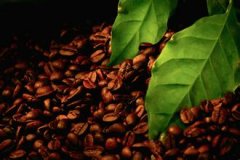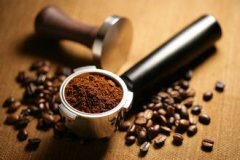Production of sweet civet coffee A brief introduction to the treatment method of grinding degree and baking degree

After processing and baking, Kopi Luwak has become a luxury coffee drink and spread to luxury kingdoms around the world. Local coffee farmers, in pursuit of high profits, bring wild civets home to raise them so that they can produce more Kopi Luwak. However, the Kopi Luwak produced by breeding civets will be much worse in color and taste. Even so, the output of this kind of coffee is still very rare, and it is not affordable for everyone who likes coffee. This coffee comes from the excrement of an animal called the civet (commonly known as the civet in Indonesia). Although it comes from smelly poop, it only feels sweet and indescribably sweet after drinking it. This wild musk cat likes to eat fat, multi-paddled coffee fruits, but the hard hard nuts (raw beans) cannot be digested and are excreted with feces. After being cleaned, they become Kopi Luwak coffee raw beans! So many people call it "cat shit" coffee.
Indonesia
It was found that after passing the civet
Gastrointestinal fermented coffee beans are very thick and mellow, so they collect civet droppings and sift out the coffee.
Beans, brewed to drink, because the yield is rare, and the fermentation process is unique, the flavor is very different from the general coffee. Traditionally, coffee fruit is washed or tanned to remove the peel, pulp and sheep skin, and finally take out the coffee beans. however, Luwak uses natural fermentation in the body to remove the coffee beans, so it has a special flavor. It is said that coffee farmers in early Indonesia regarded civet cats that ate ripe coffee fruits as mortal enemies, but at some point someone began to think of picking coffee beans from the civet droppings to make coffee with unique flavor. Coffee experts everywhere have tried and were amazed. Since then, local farmers spend a lot of time collecting civet droppings in the forest every day during the coffee ripening season.
The word Indonesia comes from the Greek Indus and n è sos, which refers to the islands of India. The name has existed since the 18th century and predates independent Indonesia. British ethnologist George George Windsor Earl published the word "Indunesians" in 1850, but he preferred to use "Malayunesians"-referring to the inhabitants of the East Indies and Malay Islands. In the same journal, James Richardson Logan, a student at Earl, refers to the East Indies as "Indonesia". However, the Dutch academic circle does not use the word Indonesia, but uses the Malay Islands, the Dutch East Indies and so on, while the words East India, East and Islands are also quite common. [7]
National flag
The Indonesian flag (Indonesian: Sang Merah Putih), also known as "Honor Red and White", is a flag composed of red and white horizontal bands. The ratio of length to width is 3:2. This flag is based on the flag of the Manchu Boyi in the 13th century. It first rose on August 17, 1945. It hasn't changed since. The design of the flag is very simple. There are two horizontal bands of the same width. The upper horizontal band is red and the lower horizontal band is white. Red symbolizes bravery and justice, as well as Indonesia's prosperity after independence; white symbolizes freedom, justice and purity, and expresses the good wishes of the Indonesian people to oppose aggression and love peace. [7]
National emblem
The Indonesian national emblem is a golden Indonesian condor with its head held high and its wings spread, symbolizing the glory and victory of the Indonesian people. On Indonesia's Independence Day in August, there are eight feathers on the tail of the condor to mark August, and 17 feathers on each wing to mark the 17th, a day that the Indonesian people should be proud of. There is a shield on the chest of the condor, and there are five patterns on the shield: the golden pentagram in the middle is a symbol of Islam, and most Indonesian citizens believe in Islam; the golden buffalo head shows people's sovereignty, and the green tree is solid and strong, just as nationalism is deeply rooted in the hearts of the Indonesian people, cotton peaches and rice ears weave a piece of prosperity, and the gold chain is tightly linked, symbolizing the equality of all ethnic groups in the country. A black horizontal line runs through the shield emblem, indicating that the equator passes through Indonesian territory. The white ribbon under the claws of the condor is inscribed in ancient Java with the Indonesian motto "all paths lead to the same goal"
The flavor is quite different from that of ordinary coffee. Traditionally, coffee fruit is washed or sun-treated to remove the skin, flesh and sheep skin, and finally take out the coffee beans, but Luwak is the use of natural fermentation in the body to take out the coffee beans, so there is a special flavor after processing and roasting, Kopi Luwak has become a luxury coffee drink, spread to luxury kingdoms all over the world. Local coffee farmers, in pursuit of high profits, bring wild civets home to raise them so that they can produce more Kopi Luwak. However, the Kopi Luwak produced by breeding civets will be much worse in color and taste. Even so, the output of this kind of coffee is still very rare, and it is not affordable for all coffee lovers. It is said that coffee farmers in early Indonesia regarded civets that specialize in ripe coffee fruits as mortal enemies. But at some point someone began to think of picking coffee beans from the civet feces to make coffee with unique flavor. Coffee experts everywhere have tried and were amazed. Since then, during the coffee ripening season, local farmers spend a lot of time every day in the forest collecting civet feces, Kopi Luwak, produced in Indonesia, one of the most expensive coffee in the world. Indonesia grows a large number of
Coffee crops, there are wild animals called civets, omnivores, pointed mouths, dark gray fur. The favorite food is fresh coffee beans, which are fermented and digested in the body and eventually excreted by cats. Feces are grains of coffee beans and become the most expensive feces in the world. Because the quantity is very rare, so the price is very expensive.
Important Notice :
前街咖啡 FrontStreet Coffee has moved to new addredd:
FrontStreet Coffee Address: 315,Donghua East Road,GuangZhou
Tel:020 38364473
- Prev

The Origin and Development of Cat Dung Coffee beans A brief introduction to the methods of Historical and Cultural Cooking
Coffee critic Chris Rubin said that the aroma of the wine is so rich and strong, and the coffee is incredibly rich, almost like syrup. Its thickness and chocolate taste, and lingering on the tongue for a long time, pure aftertaste. M.P. Mountanos, the company that first introduced Kopi Luwak coffee to the United States, pointed out that it was first heard of this in vivo fermentation.
- Next

Smooth Peruvian coffee estate flavor taste aroma characteristics Description
Organic coffee is coffee beans grown in the shade. Although the method of growing coffee beans under shade makes the yield not high, the quality can reach the level of gourmet coffee. This is because shade under the tree slows the maturation of the coffee tree, helps the coffee grow fully, makes it contain more natural ingredients, fosters better taste, and reduces caffeine content.
Related
- Detailed explanation of Jadeite planting Land in Panamanian Jadeite Manor introduction to the grading system of Jadeite competitive bidding, Red bid, Green bid and Rose Summer
- Story of Coffee planting in Brenka region of Costa Rica Stonehenge Manor anaerobic heavy honey treatment of flavor mouth
- What's on the barrel of Blue Mountain Coffee beans?
- Can American coffee also pull flowers? How to use hot American style to pull out a good-looking pattern?
- Can you make a cold extract with coffee beans? What is the right proportion for cold-extracted coffee formula?
- Indonesian PWN Gold Mandrine Coffee Origin Features Flavor How to Chong? Mandolin coffee is American.
- A brief introduction to the flavor characteristics of Brazilian yellow bourbon coffee beans
- What is the effect of different water quality on the flavor of cold-extracted coffee? What kind of water is best for brewing coffee?
- Why do you think of Rose Summer whenever you mention Panamanian coffee?
- Introduction to the characteristics of authentic blue mountain coffee bean producing areas? What is the CIB Coffee Authority in Jamaica?

